个人总结市场进入(包括MA)战略规划营销规划营销审计
市场部个人工作总结(三篇)
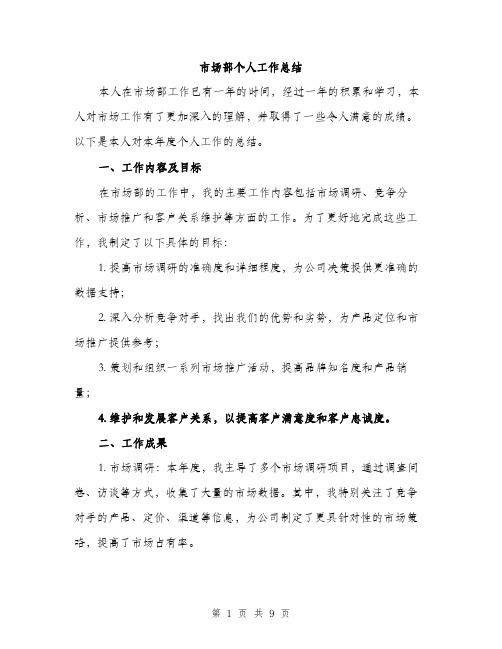
市场部个人工作总结本人在市场部工作已有一年的时间,经过一年的积累和学习,本人对市场工作有了更加深入的理解,并取得了一些令人满意的成绩。
以下是本人对本年度个人工作的总结。
一、工作内容及目标在市场部的工作中,我的主要工作内容包括市场调研、竞争分析、市场推广和客户关系维护等方面的工作。
为了更好地完成这些工作,我制定了以下具体的目标:1. 提高市场调研的准确度和详细程度,为公司决策提供更准确的数据支持;2. 深入分析竞争对手,找出我们的优势和劣势,为产品定位和市场推广提供参考;3. 策划和组织一系列市场推广活动,提高品牌知名度和产品销量;4. 维护和发展客户关系,以提高客户满意度和客户忠诚度。
二、工作成果1. 市场调研:本年度,我主导了多个市场调研项目,通过调查问卷、访谈等方式,收集了大量的市场数据。
其中,我特别关注了竞争对手的产品、定价、渠道等信息,为公司制定了更具针对性的市场策略,提高了市场占有率。
2. 竞争分析:通过对竞争对手的详细调研和分析,我发现了我们产品的优势和劣势,并根据这些结果对产品定位进行了调整。
同时,我还提出了一些市场推广的创新点,使我们的产品在市场上具有更强的竞争力。
3. 市场推广:在市场推广方面,我制定了一系列的营销活动,如线上线下活动、促销活动等,以提高品牌知名度和产品销量。
通过这些活动,我们的产品在市场上得到了更多的曝光度,并获得了更多的销售机会。
4. 客户关系维护:在客户关系的维护方面,我主动与客户保持联系,及时回复客户的问题和需求,并寻找增加客户价值的机会。
在这一年中,我成功维护了多个重要客户,并与他们建立了长期稳定的合作关系。
三、工作心得和改进措施在市场部工作的一年中,我深刻体会到了市场工作的重要性和挑战性。
以下是本人的一些工作心得和改进措施:1. 提高专业知识水平:市场部工作需要对市场环境、竞争对手、产品特性等有较深入的了解,所以我在今后会不断学习相关领域的知识,提高自己的专业素养。
个人工作总结市场方面

个人工作总结市场方面
在过去的工作中,我负责市场方面的工作,下面是我个人对这段时间的工作总结:
1. 市场调研和分析:通过对市场的调研和分析,我能够更好地了解目标市场的需求和竞争情况。
我收集了大量的数据,并进行了详细的分析,以便为公司的市场战略制定提供有力的支持。
2. 品牌推广:我参与了公司的品牌推广工作。
通过策划和执行各种营销活动,我成功地提高了品牌知名度和市场份额。
在市场推广活动方面,我积极与销售团队合作,执行各种促销计划,从而达到销售目标。
3. 市场营销策略:我参与了公司市场营销策略的制定和执行。
通过与团队的合作和沟通,我能够提出有效的市场推广方案,以提升公司产品或服务的市场竞争力。
我密切关注市场趋势和竞争对手的动态,并灵活调整市场策略,以适应市场变化。
4. 客户关系管理:与客户保持密切的合作关系对于市场工作至关重要。
我与客户进行了经常性的沟通,并主动解决他们的问题和需求。
通过建立良好的客户关系,我能够提高客户满意度,并持续引导客户对公司的忠诚度。
5. 市场效果评估:我注重市场活动的效果评估和反馈。
通过对市场数据和指标的监测和分析,我能够评估市场活动的效果,并提出改进建议。
这使得我能够及时调整市场策略和活动执行方式,以达到最佳的市场效果。
综上所述,通过这段时间的工作,我在市场方面取得了不少成果。
我将继续保持对市场的关注,并不断努力提升自己的专业能力,以更好地支持公司的市场发展和增长。
市场营销工作个人总结三篇_市场营销工作总结报告
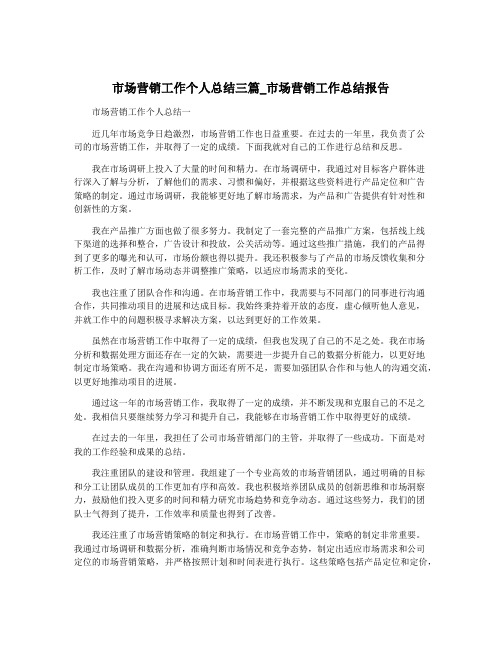
市场营销工作个人总结三篇_市场营销工作总结报告市场营销工作个人总结一近几年市场竞争日趋激烈,市场营销工作也日益重要。
在过去的一年里,我负责了公司的市场营销工作,并取得了一定的成绩。
下面我就对自己的工作进行总结和反思。
我在市场调研上投入了大量的时间和精力。
在市场调研中,我通过对目标客户群体进行深入了解与分析,了解他们的需求、习惯和偏好,并根据这些资料进行产品定位和广告策略的制定。
通过市场调研,我能够更好地了解市场需求,为产品和广告提供有针对性和创新性的方案。
我在产品推广方面也做了很多努力。
我制定了一套完整的产品推广方案,包括线上线下渠道的选择和整合,广告设计和投放,公关活动等。
通过这些推广措施,我们的产品得到了更多的曝光和认可,市场份额也得以提升。
我还积极参与了产品的市场反馈收集和分析工作,及时了解市场动态并调整推广策略,以适应市场需求的变化。
我也注重了团队合作和沟通。
在市场营销工作中,我需要与不同部门的同事进行沟通合作,共同推动项目的进展和达成目标。
我始终秉持着开放的态度,虚心倾听他人意见,并就工作中的问题积极寻求解决方案,以达到更好的工作效果。
虽然在市场营销工作中取得了一定的成绩,但我也发现了自己的不足之处。
我在市场分析和数据处理方面还存在一定的欠缺,需要进一步提升自己的数据分析能力,以更好地制定市场策略。
我在沟通和协调方面还有所不足,需要加强团队合作和与他人的沟通交流,以更好地推动项目的进展。
通过这一年的市场营销工作,我取得了一定的成绩,并不断发现和克服自己的不足之处。
我相信只要继续努力学习和提升自己,我能够在市场营销工作中取得更好的成绩。
在过去的一年里,我担任了公司市场营销部门的主管,并取得了一些成功。
下面是对我的工作经验和成果的总结。
我注重团队的建设和管理。
我组建了一个专业高效的市场营销团队,通过明确的目标和分工让团队成员的工作更加有序和高效。
我也积极培养团队成员的创新思维和市场洞察力,鼓励他们投入更多的时间和精力研究市场趋势和竞争动态。
战略个人总结报告范文(3篇)

第1篇一、前言时光荏苒,岁月如梭。
转眼间,我在公司担任战略规划岗位已有一年之久。
在这段时间里,我本着对战略规划工作的热爱与执着,努力提升自己的专业素养,积极投身于公司战略规划的各项工作。
现将一年来的工作情况进行总结,以期为今后的工作提供借鉴和改进的方向。
二、工作回顾(一)战略规划制定与实施1. 市场调研与分析在公司战略规划的制定过程中,我充分发挥自己的专业优势,对国内外市场进行了全面、深入的调研与分析。
通过收集整理行业数据、竞争对手信息、政策法规等资料,为公司战略规划的制定提供了有力支撑。
2. 战略目标设定在充分了解公司现状和市场需求的基础上,我参与了公司战略目标的设定。
通过与各部门的沟通与协调,确定了公司未来五年的发展目标,包括市场份额、盈利能力、品牌影响力等方面。
3. 战略路径规划针对战略目标的实现,我提出了具体的战略路径规划。
主要包括以下方面:- 产品战略:优化产品结构,提升产品竞争力,拓展市场空间。
- 市场战略:加大市场推广力度,提高品牌知名度,拓展市场份额。
- 品牌战略:打造企业文化,提升品牌形象,增强品牌影响力。
- 人才战略:引进和培养优秀人才,优化人才结构,提升团队整体素质。
4. 战略实施与监控在战略实施过程中,我积极参与各部门的协调与沟通,确保战略目标的顺利推进。
同时,对战略实施情况进行定期监控,及时发现并解决问题,确保战略目标的实现。
(二)内部管理与协调1. 部门协调在公司战略规划的制定与实施过程中,我充分发挥了桥梁和纽带的作用,积极协调各部门之间的工作,确保战略目标的顺利实现。
2. 团队建设我注重团队建设,通过开展培训、团队活动等形式,提升团队凝聚力,激发团队成员的积极性和创造力。
(三)个人成长与收获1. 专业知识提升在工作中,我不断学习新的专业知识,提升自己的专业素养,为更好地完成工作打下了坚实基础。
2. 沟通协调能力增强通过与各部门的沟通与协调,我的沟通协调能力得到了显著提升。
市场调查报告个人总结范文5篇

市场调查报告个人总结范文5篇总结中的经验体会是从实际工作中,也就是从大量事实材料中提炼出来的。
经验体会一旦形成,又要选择必要的材料予以说明,经验体会才能“立”起来,具有实用价值,这里给大家分享一些关于市场调查报告个人总结范文,供大家参考。
市场调查报告个人总结范文1(一)市场概况有数据显示,__珠宝业目前正处于一种不断上升的趋势,每年都以15%左右的速度增长。
20__年__市珠宝销售量在全国排名前十,珠宝商店单位面积销量在全国属较高水平。
正是有如此大的市场空间,很多国内外的著名珠宝品牌都纷纷进入__,比较知名的有周大福、谢瑞鳞、周大生、ARTINI等国际品牌和明牌、老凤祥、万隆、华友、潮宏基等一些国内品牌,使__珠宝市场形成了品牌林立、诸侯争雄的格局。
__珠宝市场的另一个显著变化是,之前一直是大商场一枝独秀的局面自20__年开始风云突变,专卖店奇军突起,万隆珠宝开进__商业心脏武林地区,瑞祥珠宝引进意大利美地亚品牌并增设上海老凤祥银楼门店,其三家专卖店面积总和超过江汉路上五家大商场中珠宝占地面积的总和。
大商场和珠宝专卖店两种业态并存,客观上起到了一个互补的作用,__珠宝市场这块蛋糕开始越做越大,竞争也开始越来越激烈。
(二)商圈分布目前__市场几乎所有的珠宝品牌全部集中在江汉路和体育场路繁华地段的武林商圈,竞争半径不超过100米,对于消费者来说,购买的时间成本、交通成本和体力成本几乎完全一样,因此选择弹性很大,而对于珠宝商家而言,在同一个地方争夺同一个客群,无疑提高了竞争难度。
(三)营销组合策略1、产品策略:从各店陈列的产品来看,无论是品种、款式,产品基本无任何差异,材质也趋于统一,在专家的眼里可能会有不同,但是我相信在顾客的眼里完全一样。
值得一提的是,万隆的产品里面彩钻、异型钻的比例较大,钻戒主要经营30分以上的品种,美地亚店陈列有净度为LC的极品钻戒,而翡翠物语全部经营翡翠、玉石,这都是追求产品差异化的一种努力。
市场部个人总结工作总结5篇

市场部个人总结工作总结5篇(经典版)编制人:__________________审核人:__________________审批人:__________________编制单位:__________________编制时间:____年____月____日序言下载提示:该文档是本店铺精心编制而成的,希望大家下载后,能够帮助大家解决实际问题。
文档下载后可定制修改,请根据实际需要进行调整和使用,谢谢!并且,本店铺为大家提供各种类型的经典范文,如总结报告、事迹材料、心得体会、讲话致辞、规章制度、应急预案、合同协议、教学资料、作文大全、其他范文等等,想了解不同范文格式和写法,敬请关注!Download tips: This document is carefully compiled by this editor. I hope that after you download it, it can help you solve practical problems. The document can be customized and modified after downloading, please adjust and use it according to actual needs, thank you!Moreover, our store provides various types of classic sample essays, such as summary reports, performance materials, insights, speeches, rules and regulations, emergency plans, contract agreements, teaching materials, essay summaries, and other sample essays. If you would like to learn about different sample formats and writing methods, please pay attention!市场部个人总结工作总结5篇通过个人总结,我可以发现自己在某些方面需要加强的自我管理能力,个人总结可以帮助我更好地规划和实现自己的目标,以下是本店铺精心为您推荐的市场部个人总结工作总结5篇,供大家参考。
工作总结市场趋势分析与战略规划

工作总结市场趋势分析与战略规划在当今竞争激烈的商业环境中,市场趋势的变化犹如风云变幻,难以捉摸。
对于企业而言,准确把握市场趋势并制定有效的战略规划是生存和发展的关键。
以下是对过去工作的总结,以及对市场趋势的分析和未来战略规划的思考。
一、过去工作总结过去的一段时间里,我们在市场开拓方面取得了一定的成绩。
通过市场调研和客户需求分析,成功推出了一系列符合市场需求的产品和服务。
然而,也面临了一些挑战和问题。
在销售渠道方面,虽然拓展了线上销售渠道,但线下渠道的优化和整合还不够完善,导致部分地区的市场覆盖不足。
产品方面,部分产品在性能和质量上与竞争对手相比存在差距,需要进一步改进和提升。
营销活动的策划和执行效果也有待提高,部分活动未能精准触达目标客户群体,导致资源浪费。
在团队协作方面,各部门之间的沟通和协调还存在一定的障碍,影响了工作效率和决策的及时性。
同时,人才培养和激励机制不够健全,导致部分员工的积极性和创造力没有得到充分发挥。
二、市场趋势分析(一)行业发展趋势随着科技的不断进步和消费者需求的升级,行业呈现出以下几个主要发展趋势:1、数字化转型加速:越来越多的企业将业务流程数字化,以提高效率和竞争力。
2、个性化需求增长:消费者对于个性化、定制化的产品和服务需求日益强烈。
3、绿色环保成为主流:消费者对环保产品和可持续发展的关注度不断提高。
(二)竞争态势市场竞争愈发激烈,竞争对手不断推出创新产品和服务,价格战也时有发生。
同时,新的竞争对手不断涌入市场,进一步加剧了竞争压力。
(三)消费者行为变化消费者的购买决策过程更加复杂,更加注重产品的品质、品牌形象和售后服务。
此外,社交媒体和在线评论对消费者的购买决策影响越来越大。
三、战略规划(一)产品策略1、加大研发投入,提升产品性能和质量,推出更多具有竞争力的创新产品。
2、关注消费者个性化需求,提供定制化的产品和服务解决方案。
(二)渠道策略1、优化线下渠道布局,加强与经销商的合作,提高市场覆盖率。
年度市场工作总结个人
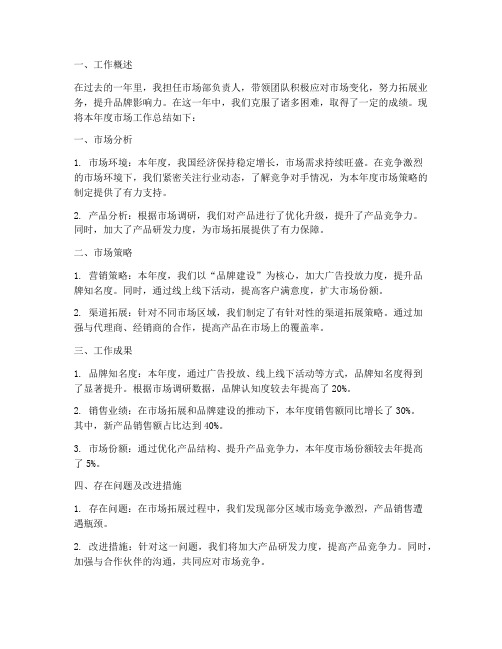
一、工作概述在过去的一年里,我担任市场部负责人,带领团队积极应对市场变化,努力拓展业务,提升品牌影响力。
在这一年中,我们克服了诸多困难,取得了一定的成绩。
现将本年度市场工作总结如下:一、市场分析1. 市场环境:本年度,我国经济保持稳定增长,市场需求持续旺盛。
在竞争激烈的市场环境下,我们紧密关注行业动态,了解竞争对手情况,为本年度市场策略的制定提供了有力支持。
2. 产品分析:根据市场调研,我们对产品进行了优化升级,提升了产品竞争力。
同时,加大了产品研发力度,为市场拓展提供了有力保障。
二、市场策略1. 营销策略:本年度,我们以“品牌建设”为核心,加大广告投放力度,提升品牌知名度。
同时,通过线上线下活动,提高客户满意度,扩大市场份额。
2. 渠道拓展:针对不同市场区域,我们制定了有针对性的渠道拓展策略。
通过加强与代理商、经销商的合作,提高产品在市场上的覆盖率。
三、工作成果1. 品牌知名度:本年度,通过广告投放、线上线下活动等方式,品牌知名度得到了显著提升。
根据市场调研数据,品牌认知度较去年提高了20%。
2. 销售业绩:在市场拓展和品牌建设的推动下,本年度销售额同比增长了30%。
其中,新产品销售额占比达到40%。
3. 市场份额:通过优化产品结构、提升产品竞争力,本年度市场份额较去年提高了5%。
四、存在问题及改进措施1. 存在问题:在市场拓展过程中,我们发现部分区域市场竞争激烈,产品销售遭遇瓶颈。
2. 改进措施:针对这一问题,我们将加大产品研发力度,提高产品竞争力。
同时,加强与合作伙伴的沟通,共同应对市场竞争。
五、展望未来1. 市场趋势:随着我国经济的持续增长,市场需求将进一步扩大。
未来,我们将继续关注市场动态,把握市场机遇。
2. 发展规划:为满足市场需求,我们将加大产品研发力度,提升产品竞争力。
同时,拓展市场渠道,提高市场份额。
总之,过去的一年,我们在市场工作中取得了一定的成绩。
在新的一年里,我们将继续努力,为我国市场的发展贡献自己的力量。
市场营销个人工作总结
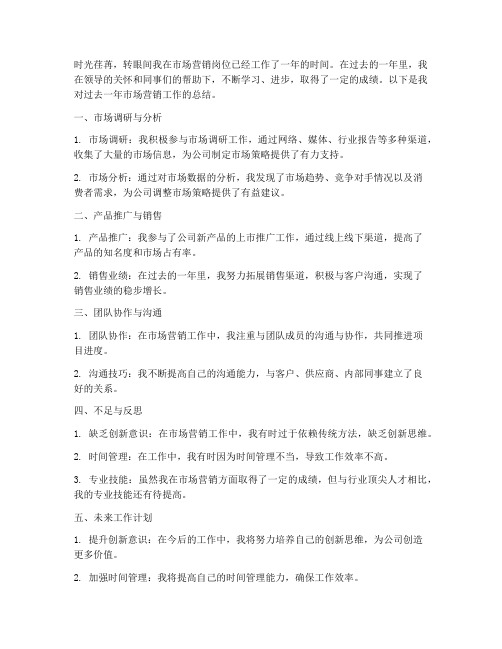
时光荏苒,转眼间我在市场营销岗位已经工作了一年的时间。
在过去的一年里,我在领导的关怀和同事们的帮助下,不断学习、进步,取得了一定的成绩。
以下是我对过去一年市场营销工作的总结。
一、市场调研与分析1. 市场调研:我积极参与市场调研工作,通过网络、媒体、行业报告等多种渠道,收集了大量的市场信息,为公司制定市场策略提供了有力支持。
2. 市场分析:通过对市场数据的分析,我发现了市场趋势、竞争对手情况以及消费者需求,为公司调整市场策略提供了有益建议。
二、产品推广与销售1. 产品推广:我参与了公司新产品的上市推广工作,通过线上线下渠道,提高了产品的知名度和市场占有率。
2. 销售业绩:在过去的一年里,我努力拓展销售渠道,积极与客户沟通,实现了销售业绩的稳步增长。
三、团队协作与沟通1. 团队协作:在市场营销工作中,我注重与团队成员的沟通与协作,共同推进项目进度。
2. 沟通技巧:我不断提高自己的沟通能力,与客户、供应商、内部同事建立了良好的关系。
四、不足与反思1. 缺乏创新意识:在市场营销工作中,我有时过于依赖传统方法,缺乏创新思维。
2. 时间管理:在工作中,我有时因为时间管理不当,导致工作效率不高。
3. 专业技能:虽然我在市场营销方面取得了一定的成绩,但与行业顶尖人才相比,我的专业技能还有待提高。
五、未来工作计划1. 提升创新意识:在今后的工作中,我将努力培养自己的创新思维,为公司创造更多价值。
2. 加强时间管理:我将提高自己的时间管理能力,确保工作效率。
3. 提升专业技能:我将继续学习市场营销相关知识,提高自己的专业技能。
总之,过去的一年是我成长和进步的一年。
在今后的工作中,我将继续努力,为公司的发展贡献自己的力量。
我相信,在领导的关怀和同事们的帮助下,我会在市场营销岗位上取得更加优异的成绩。
市场营部个人总结
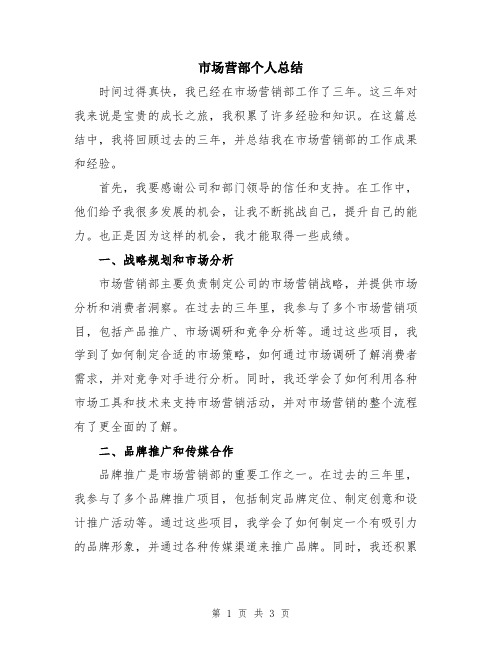
市场营部个人总结时间过得真快,我已经在市场营销部工作了三年。
这三年对我来说是宝贵的成长之旅,我积累了许多经验和知识。
在这篇总结中,我将回顾过去的三年,并总结我在市场营销部的工作成果和经验。
首先,我要感谢公司和部门领导的信任和支持。
在工作中,他们给予我很多发展的机会,让我不断挑战自己,提升自己的能力。
也正是因为这样的机会,我才能取得一些成绩。
一、战略规划和市场分析市场营销部主要负责制定公司的市场营销战略,并提供市场分析和消费者洞察。
在过去的三年里,我参与了多个市场营销项目,包括产品推广、市场调研和竞争分析等。
通过这些项目,我学到了如何制定合适的市场策略,如何通过市场调研了解消费者需求,并对竞争对手进行分析。
同时,我还学会了如何利用各种市场工具和技术来支持市场营销活动,并对市场营销的整个流程有了更全面的了解。
二、品牌推广和传媒合作品牌推广是市场营销部的重要工作之一。
在过去的三年里,我参与了多个品牌推广项目,包括制定品牌定位、制定创意和设计推广活动等。
通过这些项目,我学会了如何制定一个有吸引力的品牌形象,并通过各种传媒渠道来推广品牌。
同时,我还积累了丰富的传媒合作经验,学会了如何与媒体合作,提高品牌曝光度。
三、数字营销和社交媒体推广随着网络的发展,数字营销和社交媒体推广变得越来越重要。
在过去的三年里,我积极学习了数字营销和社交媒体推广的知识,并参与了多个数字营销项目。
通过这些项目,我学到了如何利用数字渠道来进行定位、宣传和推广,并学会了如何通过社交媒体吸引客户和维护品牌形象。
我还熟悉了各种数字营销工具,包括SEO、SEM和社交媒体分析工具等。
四、团队合作和领导力在市场营销部的工作,离不开团队合作。
在过去的三年里,我参与了许多团队项目,并担任过一些项目的负责人。
通过这些项目,我学会了如何与团队成员合作,分工合作,共同完成项目。
同时,我还学会了如何发挥自己的领导力,带领团队一起努力,达成目标。
这些经验对我的个人成长和职业发展都有很大的帮助。
市场部个人工作总结5篇

市场部个人工作总结市场部个人工作总结精选5篇〔一〕作为市场部的一员,我们的工作需要基于市场环境和竞争状况迅速的反响,发挥团队优势,协作完成各项工作任务。
作为一名市场部的员工,我深化认识到了团队的重要性和自我提升的重要性。
下面,我将从个人角度出发,总结一下自己的工作经历和感悟。
市场部的工作的核心是为公司带来业务增长。
在这方面,我个人主要负责了市场细分和定位,竞争状况的分析,市场的推广策略以及市场调研和分析的工作。
在市场细分方面,我的工作重点是细化客户需求,理解客户心理和客户对公司产品的诉求,并以此为根底,发挥团队的优势,制定更为细致的市场推广策略。
另外,在竞争状况的分析方面,我也发挥了自己的优势实际,深化挖掘竞争对手的优势和缺乏,并建立了一套完好的竞争分析体系,实现了市场竞争优势的保障。
市场部的工作需要整个部门的协作和同整个公司的其他部门的沟通。
在组织施行部门内部工作时,我深化理解了各组员的才能和特长,并根据任务的需要进展合理的分工,使我们可以更有效的完成工作任务。
在与其他部门协作时,我通过积极的沟通协调,建立了有效的合作形式,加强了部门间的联络,进步了工作效率。
作为一名市场部员工,我非常注重自己的综合素质提升。
不断学习和提升自己的知识才能和技术才能,使自己更加成熟和可以胜任更高级的工作。
在这方面,我通过阅读市场营销专业书籍以及参加线下课程,増强了我的专业知识储藏。
同时,我还积极的参加公司内部培训,稳固了自己的技能和为公司更为出色的工作做出了奉献。
以上是我个人在市场部的工作总结,通过这份总结,我不断完善自己的各个方面,为成功的实现团队目的做出更多努力。
市场部个人工作总结精选5篇〔二〕尊敬的领导:值此20__年末,市场部成员再次在您的关心下完成了全年的工作。
在您的指导下,我们全体成员团结协作、勤奋努力,以实际行动为企业增添新的辉煌。
今年的市场部工作,与以往相比更加困难和繁重。
面对市场环境变化的不确定性,我们要不断进步自身的素质和应对才能,不断调整思路和方法,积极开展市场工作。
市场营销工作个人总结范文
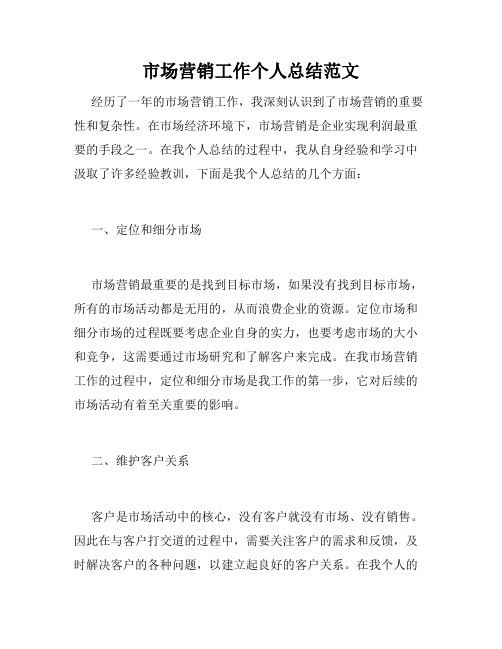
市场营销工作个人总结范文经历了一年的市场营销工作,我深刻认识到了市场营销的重要性和复杂性。
在市场经济环境下,市场营销是企业实现利润最重要的手段之一。
在我个人总结的过程中,我从自身经验和学习中汲取了许多经验教训,下面是我个人总结的几个方面:一、定位和细分市场市场营销最重要的是找到目标市场,如果没有找到目标市场,所有的市场活动都是无用的,从而浪费企业的资源。
定位市场和细分市场的过程既要考虑企业自身的实力,也要考虑市场的大小和竞争,这需要通过市场研究和了解客户来完成。
在我市场营销工作的过程中,定位和细分市场是我工作的第一步,它对后续的市场活动有着至关重要的影响。
二、维护客户关系客户是市场活动中的核心,没有客户就没有市场、没有销售。
因此在与客户打交道的过程中,需要关注客户的需求和反馈,及时解决客户的各种问题,以建立起良好的客户关系。
在我个人的市场营销工作中,我发现积极跟进客户反馈是一个很好的方式,通过了解客户反馈我不仅可以改进产品,也可以提高客户的满意度,从而增加客户的忠诚度。
三、整合营销资源市场营销包括产品研发、渠道建设、品牌建设、促销等多方面,涉及到多个部门和工作人员的协作。
因此,需要整合企业内部资源,使得各个部门之间协调配合,形成有力的市场营销团队。
在我个人的市场营销工作中,我发现协调良好、有明确目标和任务分工的团队,在市场活动中能够更加高效地完成工作,从而为企业创造更多的价值。
四、跟踪竞争动态市场营销的一个重要组成部分就是竞争分析。
对于企业来说,了解和分析竞争对手的市场策略、产品进展、营销活动以及消费者反馈等信息,以便更好地制定自己的市场策略,并及时调整自己的营销方向。
在我市场营销工作中,我经常通过搜索竞争对手的网站来获取他们的产品信息、营销活动信息和客户反馈,以此为依据,为自己的市场活动做出更加明智的决策,提高企业的竞争优势。
综上所述,市场营销是企业实现利润最重要的手段之一,市场营销的核心是客户。
个人市场工作总结精简

个人市场工作总结精简在过去的一年里,我在个人市场工作方面取得了一定的成绩和经验。
以下是我的工作总结:一、市场调研与分析我首先对目标市场进行了深入的调研和分析,通过收集和整理数据,了解消费者的需求和市场趋势。
我利用问卷调查、在线访谈和市场分析报告等方式,收集了大量第一手资料,为制定市场策略提供了依据。
二、市场策略制定根据市场调研结果,我制定了针对性的市场策略。
这包括产品定位、价格策略、促销活动和渠道选择等。
我注重市场细分,针对不同的消费者群体,提供差异化的服务和产品。
三、产品推广与销售在产品推广方面,我采取了线上线下相结合的方式。
线上通过社交媒体、电子邮件营销和网络广告等方式,扩大品牌影响力;线下则通过参加行业展会、举办产品发布会等形式,增强与客户的互动和信任。
四、客户关系管理我重视与客户的长期关系建设,通过CRM系统跟踪客户的购买历史和偏好,定期发送个性化的促销信息和产品更新。
同时,我也积极收集客户的反馈,不断优化产品和服务。
五、团队协作与个人成长在团队协作方面,我与同事们保持良好的沟通和协作,共同完成市场推广任务。
个人成长方面,我通过参加培训和自学,不断提升自己的市场分析能力和营销技巧。
六、问题与挑战在市场工作中,我也遇到了一些问题和挑战,如市场竞争加剧、客户需求多变等。
面对这些问题,我积极寻求解决方案,如调整市场策略、加强产品创新等。
七、未来展望展望未来,我计划继续深化市场研究,探索新的市场机会。
同时,我也将加强团队建设,提高团队的整体执行力和创新能力,以适应市场的变化和发展。
总结过去,展望未来,我相信通过不断的努力和创新,我们能够在个人市场工作中取得更大的成功。
市场营销工作个人年度总结范文
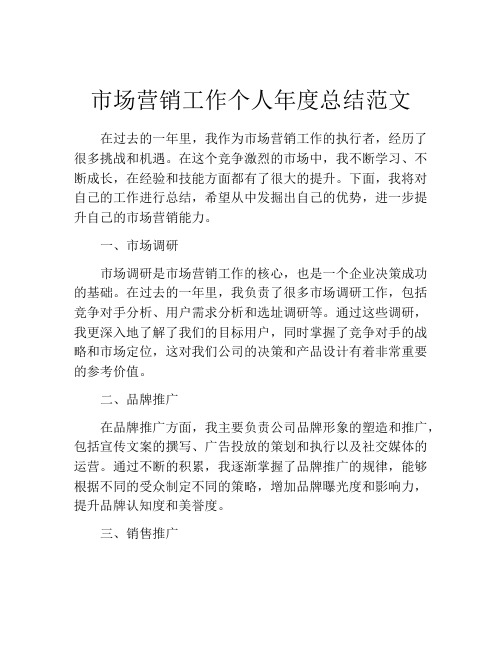
市场营销工作个人年度总结范文在过去的一年里,我作为市场营销工作的执行者,经历了很多挑战和机遇。
在这个竞争激烈的市场中,我不断学习、不断成长,在经验和技能方面都有了很大的提升。
下面,我将对自己的工作进行总结,希望从中发掘出自己的优势,进一步提升自己的市场营销能力。
一、市场调研市场调研是市场营销工作的核心,也是一个企业决策成功的基础。
在过去的一年里,我负责了很多市场调研工作,包括竞争对手分析、用户需求分析和选址调研等。
通过这些调研,我更深入地了解了我们的目标用户,同时掌握了竞争对手的战略和市场定位,这对我们公司的决策和产品设计有着非常重要的参考价值。
二、品牌推广在品牌推广方面,我主要负责公司品牌形象的塑造和推广,包括宣传文案的撰写、广告投放的策划和执行以及社交媒体的运营。
通过不断的积累,我逐渐掌握了品牌推广的规律,能够根据不同的受众制定不同的策略,增加品牌曝光度和影响力,提升品牌认知度和美誉度。
三、销售推广销售推广是企业实现营收的关键环节。
在过去的一年里,我负责了很多的销售推广活动,包括大型促销活动、产品发布会和新客户拓展等。
通过这些推广活动,我们公司吸引了更多的目标客户,并实现了销售业绩的增长,同时也提升了我们在市场中的竞争力。
四、数据分析市场营销需要对数据进行收集和分析,以便参考下一步的决策。
作为一名市场营销人员,我需要了解每一项营销活动的收益和成本,以及目标群体的需求和反馈。
因此,我熟练掌握了市场营销常用的数据分析工具,在分析数据的同时,也学会了挖掘数据背后的价值和意义,帮助公司进行未来的市场策略制定。
五、团队合作市场营销的成功需要团队的协作。
在过去的一年里,我与公司的其他部门进行了很多的合作,例如产品部门、设计部门和销售部门等,并参与了多个跨部门的项目。
通过与其他部门的合作,我深刻认识到了市场营销必须与其他部门密切合作,才能更好地实现企业的目标。
总之,过去的一年是我不断学习、成长和进步的一年。
个人工作总结市场方面
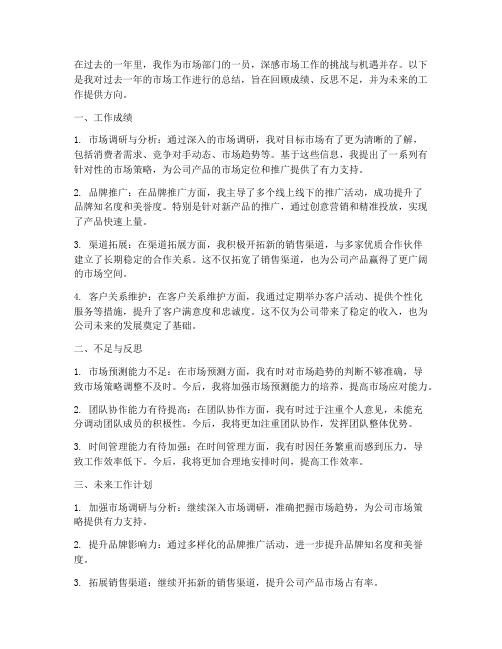
在过去的一年里,我作为市场部门的一员,深感市场工作的挑战与机遇并存。
以下是我对过去一年的市场工作进行的总结,旨在回顾成绩、反思不足,并为未来的工作提供方向。
一、工作成绩1. 市场调研与分析:通过深入的市场调研,我对目标市场有了更为清晰的了解,包括消费者需求、竞争对手动态、市场趋势等。
基于这些信息,我提出了一系列有针对性的市场策略,为公司产品的市场定位和推广提供了有力支持。
2. 品牌推广:在品牌推广方面,我主导了多个线上线下的推广活动,成功提升了品牌知名度和美誉度。
特别是针对新产品的推广,通过创意营销和精准投放,实现了产品快速上量。
3. 渠道拓展:在渠道拓展方面,我积极开拓新的销售渠道,与多家优质合作伙伴建立了长期稳定的合作关系。
这不仅拓宽了销售渠道,也为公司产品赢得了更广阔的市场空间。
4. 客户关系维护:在客户关系维护方面,我通过定期举办客户活动、提供个性化服务等措施,提升了客户满意度和忠诚度。
这不仅为公司带来了稳定的收入,也为公司未来的发展奠定了基础。
二、不足与反思1. 市场预测能力不足:在市场预测方面,我有时对市场趋势的判断不够准确,导致市场策略调整不及时。
今后,我将加强市场预测能力的培养,提高市场应对能力。
2. 团队协作能力有待提高:在团队协作方面,我有时过于注重个人意见,未能充分调动团队成员的积极性。
今后,我将更加注重团队协作,发挥团队整体优势。
3. 时间管理能力有待加强:在时间管理方面,我有时因任务繁重而感到压力,导致工作效率低下。
今后,我将更加合理地安排时间,提高工作效率。
三、未来工作计划1. 加强市场调研与分析:继续深入市场调研,准确把握市场趋势,为公司市场策略提供有力支持。
2. 提升品牌影响力:通过多样化的品牌推广活动,进一步提升品牌知名度和美誉度。
3. 拓展销售渠道:继续开拓新的销售渠道,提升公司产品市场占有率。
4. 加强团队建设:注重团队协作,发挥团队整体优势,提高工作效率。
市场营销工作个人总结

市场营销工作个人总结我在市场营销工作中已经工作了多年,累计的经验让我拥有了一定的独特见解。
在这篇文档中,我想总结我在市场营销工作中的经验和教训,并与大家分享。
我将系统地从以下几个方面进行阐述。
1.认识市场市场是我们的目标受众群体,每个市场都有自己的规则和玩法。
我们需要清楚地了解市场,并逐步建立市场画像。
包括人口、文化、经济水平等信息。
通过市场画像,我们可以帮助自己更好地了解目标受众,然后制定更精确的营销策略和计划。
同时,我们还需要时刻观察市场的变化,跟随市场的趋势和潮流,向市场提供更为切实的产品和服务。
2.制定营销策略产品定位是制定营销策略的基础前提。
我们需要准确地了解产品的特性和竞争对手的优劣势,并基于产品定位来制定明确的营销策略。
分析目标受众,最终确定针对目标人群的营销手段和营销渠道,如打通线上的Facebook、Instagram、Twitter等渠道,同时在线下也不断发展更多的资源。
3.执行营销计划营销计划执行是营销成功的关键。
我们需要遵循精细的流程,按照时间节点执行各项任务,同时及时跟进任务进展和细节情况。
营销计划要创意十足,设计搞笑的营销活动,进而吸引消费者的关注力,最终达到销量的目标。
4.关注跟进效果制定改进措施营销工作是一个不断反复验证的过程。
根据营销计划执行的效果,我们需要及时评估并调整营销策略,制定改进措施,以期实现更理想的营销效果。
结语市场营销工作是一项高度复杂、精益求精的工作。
需要我们在不断实践中不断探索,总结经验,并及时总结教训,以期最终优化营销策略。
我们需要不断学习,打破常规,创造创新,一步步为企业赢得成功和发展。
市场营销工作个人总结
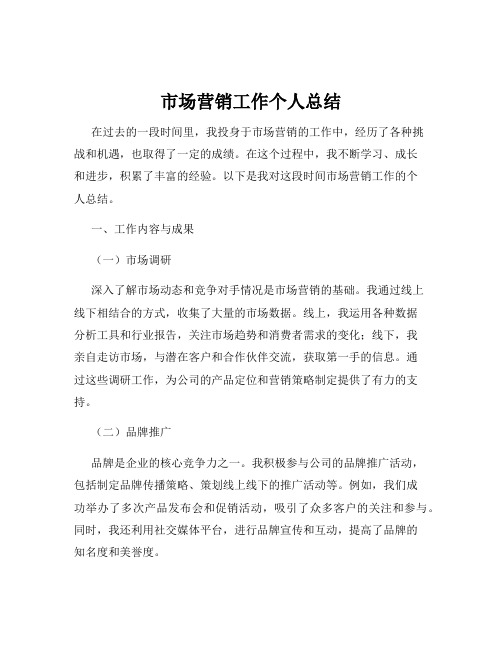
市场营销工作个人总结在过去的一段时间里,我投身于市场营销的工作中,经历了各种挑战和机遇,也取得了一定的成绩。
在这个过程中,我不断学习、成长和进步,积累了丰富的经验。
以下是我对这段时间市场营销工作的个人总结。
一、工作内容与成果(一)市场调研深入了解市场动态和竞争对手情况是市场营销的基础。
我通过线上线下相结合的方式,收集了大量的市场数据。
线上,我运用各种数据分析工具和行业报告,关注市场趋势和消费者需求的变化;线下,我亲自走访市场,与潜在客户和合作伙伴交流,获取第一手的信息。
通过这些调研工作,为公司的产品定位和营销策略制定提供了有力的支持。
(二)品牌推广品牌是企业的核心竞争力之一。
我积极参与公司的品牌推广活动,包括制定品牌传播策略、策划线上线下的推广活动等。
例如,我们成功举办了多次产品发布会和促销活动,吸引了众多客户的关注和参与。
同时,我还利用社交媒体平台,进行品牌宣传和互动,提高了品牌的知名度和美誉度。
(三)客户关系管理客户是企业的生命之源。
我注重与客户建立良好的关系,及时回复客户的咨询和投诉,解决客户的问题,提高客户满意度和忠诚度。
通过定期的客户回访和市场调查,了解客户的需求和反馈,为产品改进和服务优化提供了依据。
(四)销售支持为了促进销售业绩的提升,我与销售团队紧密合作,提供市场分析和营销策略方面的支持。
我协助制定销售计划和目标,提供市场推广资料和销售工具,组织培训和分享会,提高销售团队的业务能力和市场敏感度。
在大家的共同努力下,我们成功完成了销售任务,取得了不错的业绩。
二、工作中的经验与教训(一)团队合作的重要性市场营销工作不是一个人的战斗,需要与各个部门密切合作。
在与研发、销售、客服等部门的沟通协作中,我深刻体会到了团队合作的力量。
只有大家齐心协力,才能更好地实现公司的目标。
(二)不断学习和创新市场环境变化迅速,消费者需求不断更新。
如果不能及时学习和掌握新的营销理念和方法,就很容易被市场淘汰。
市场营销工作个人总结三篇_市场营销工作总结报告
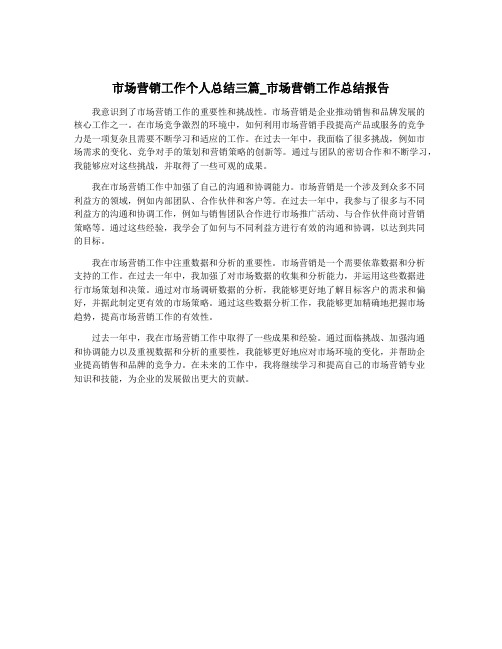
市场营销工作个人总结三篇_市场营销工作总结报告我意识到了市场营销工作的重要性和挑战性。
市场营销是企业推动销售和品牌发展的核心工作之一。
在市场竞争激烈的环境中,如何利用市场营销手段提高产品或服务的竞争力是一项复杂且需要不断学习和适应的工作。
在过去一年中,我面临了很多挑战,例如市场需求的变化、竞争对手的策划和营销策略的创新等。
通过与团队的密切合作和不断学习,我能够应对这些挑战,并取得了一些可观的成果。
我在市场营销工作中加强了自己的沟通和协调能力。
市场营销是一个涉及到众多不同利益方的领域,例如内部团队、合作伙伴和客户等。
在过去一年中,我参与了很多与不同利益方的沟通和协调工作,例如与销售团队合作进行市场推广活动、与合作伙伴商讨营销策略等。
通过这些经验,我学会了如何与不同利益方进行有效的沟通和协调,以达到共同的目标。
我在市场营销工作中注重数据和分析的重要性。
市场营销是一个需要依靠数据和分析支持的工作。
在过去一年中,我加强了对市场数据的收集和分析能力,并运用这些数据进行市场策划和决策。
通过对市场调研数据的分析,我能够更好地了解目标客户的需求和偏好,并据此制定更有效的市场策略。
通过这些数据分析工作,我能够更加精确地把握市场趋势,提高市场营销工作的有效性。
过去一年中,我在市场营销工作中取得了一些成果和经验。
通过面临挑战、加强沟通和协调能力以及重视数据和分析的重要性,我能够更好地应对市场环境的变化,并帮助企业提高销售和品牌的竞争力。
在未来的工作中,我将继续学习和提高自己的市场营销专业知识和技能,为企业的发展做出更大的贡献。
个人工作总结市场规划
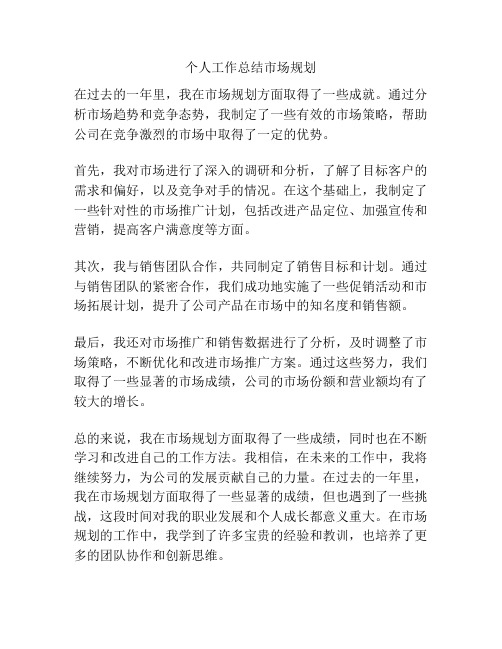
个人工作总结市场规划在过去的一年里,我在市场规划方面取得了一些成就。
通过分析市场趋势和竞争态势,我制定了一些有效的市场策略,帮助公司在竞争激烈的市场中取得了一定的优势。
首先,我对市场进行了深入的调研和分析,了解了目标客户的需求和偏好,以及竞争对手的情况。
在这个基础上,我制定了一些针对性的市场推广计划,包括改进产品定位、加强宣传和营销,提高客户满意度等方面。
其次,我与销售团队合作,共同制定了销售目标和计划。
通过与销售团队的紧密合作,我们成功地实施了一些促销活动和市场拓展计划,提升了公司产品在市场中的知名度和销售额。
最后,我还对市场推广和销售数据进行了分析,及时调整了市场策略,不断优化和改进市场推广方案。
通过这些努力,我们取得了一些显著的市场成绩,公司的市场份额和营业额均有了较大的增长。
总的来说,我在市场规划方面取得了一些成绩,同时也在不断学习和改进自己的工作方法。
我相信,在未来的工作中,我将继续努力,为公司的发展贡献自己的力量。
在过去的一年里,我在市场规划方面取得了一些显著的成绩,但也遇到了一些挑战,这段时间对我的职业发展和个人成长都意义重大。
在市场规划的工作中,我学到了许多宝贵的经验和教训,也培养了更多的团队协作和创新思维。
首先,通过市场调研和数据分析,我更深入地了解了市场的整体趋势和客户需求。
通过细致深入的研究,我得以更精准地把握市场的动向和客户需求的细微变化。
这为公司的产品定位、营销策略以及销售方向提供了更坚实的数据支持,使我们的决策更加科学和有效。
其次,我和销售团队的紧密合作也为公司带来了一定的收益。
通过与销售团队沟通交流,我们共同确定了销售目标和计划,并通过市场推广和客户关系维护等方式,有效地落实了这些目标和计划。
这种协作的模式也增进了部门之间的合作与信任,为公司的整体发展打下了更加坚实的基础。
不过,市场规划也存在一些挑战。
比如在竞争激烈的市场环境中,制定出更为独特有效的市场策略是一个不断变化和挑战的过程。
市场营销自我总结

市场营销自我总结一、工作回顾1. 营销活动在过去的一年里,我参与了公司组织的多个营销活动,包括展会、促销活动和网络营销等。
通过这些活动,我了解了市场营销的基本概念和方法,学会了如何制定营销计划、策划活动和推广产品。
同时,我也意识到了营销活动需要考虑到各种因素,如市场需求、竞争对手、消费者行为等,只有全面考虑才能取得更好的效果。
2. 客户关系管理在市场营销中,客户关系管理是非常重要的一环。
我学会了如何建立和维护客户关系,如定期沟通、了解客户需求、提供优质服务等等。
通过与客户的交流,我了解到了客户的痛点和需求,这为产品开发和改进提供了很好的参考。
3. 市场调研市场调研是市场营销中不可或缺的一部分,通过市场调研,我们可以了解市场趋势、竞争对手情况和消费者行为等。
在过去的一年里,我参与了一些市场调研工作,学会了如何设计调研问卷、收集和分析数据,以及如何提出有效的建议和解决方案。
4. 团队协作在市场营销中,团队协作是非常重要的。
我学会了如何与团队成员合作,共同完成营销任务和目标。
我意识到,只有良好的沟通和协作才能取得更好的效果。
二、经验教训1. 持续学习市场营销是一个不断变化和发展的领域,需要不断学习和更新知识。
我意识到,只有不断学习才能跟上市场的变化和需求,才能更好地为公司的市场营销工作做出贡献。
2. 注重细节市场营销中,细节决定成败。
我意识到,在工作中需要注重细节,如文案撰写、数据分析和市场调研等。
只有注重细节才能更好地完成工作,提高工作效率和质量。
3. 调整策略市场营销中,策略的调整是非常重要的。
我意识到,需要根据市场变化和客户需求来调整策略,以取得更好的效果。
同时,也需要不断尝试新的方法和手段,以保持市场竞争优势。
三、未来规划1. 提高专业技能在未来的一年里,我将继续提高自己的专业技能,如市场分析、品牌管理和营销策划等。
我将通过参加培训、阅读相关书籍和文献等方式来提高自己的专业技能水平。
2. 加强团队协作在未来的一年里,我将更加注重团队协作,与团队成员保持良好的沟通和协作关系。
- 1、下载文档前请自行甄别文档内容的完整性,平台不提供额外的编辑、内容补充、找答案等附加服务。
- 2、"仅部分预览"的文档,不可在线预览部分如存在完整性等问题,可反馈申请退款(可完整预览的文档不适用该条件!)。
- 3、如文档侵犯您的权益,请联系客服反馈,我们会尽快为您处理(人工客服工作时间:9:00-18:30)。
Step 1 Marketing Entry & Industry Insight Market Outlook Understand research objective Understand the research product scope o Understand the industry value chain - value chain, stakeholders’ num., type, trend and o profitability Examine the market attractiveness and risk (PEST) Market Size (production, demand, import and export), market trend and profitability o Influencing factors: policy, economic, society, technology and other factors including logistic, o e-business… For material product + End-Downstream market intelligence - Market Size (from supplier or purchaser), market share, o market trend, export/import volume, policy and regulation End-Downstream Key player intelligence – launch time, product, investment...& Capacity, o Produce volume, sales intelligence End-Downstream dynamic intelligence o Direct-Downstream market intelligence - production, (research) product use volume, it’s main o supplier Compete Insight (who’s our competitor? Wh at they have down?) 1 Outlook Competitor outlook - num., type, location, concentration ratio, classification, trend and who’s o key player 2 Key player performance Basic Intelligence o Key Intelligence - o Manufacture Performance - plant, equipment, technology, outsourcing, capacity usage rate Sales Performance - revenue, market share, main client Marketing Performance - 4P and SWOT analysis Distribution Performance - Channel Analysis and incentive Summary: What’s thei r KSF (raw material supply (steady supply, high quality material) – o manufacture (core technology, quality control, cost optimization) –distribution (in time、steady、low-cost) - leading service (before-sales service、after-sales service…) Consumer Insight (w ho’s our consumer? What they want) 1 Outlook Consumer outlook - Downstream industry outlook – number, type, share, location, profitability o and trend & who’s key downstream industry (for FMCG, it means market size, trend, purchasing power, loc ation…) 2 Downstream application Location, number, concentration ratio, how use and impact on product o For company sourcing process, decision maker, KBF, demand oself-market performance, develop trend & plan o for material product + What kind of products is directly purchased by End-Upstream, what kind is indirectly purchased o The proportion for directly and indirectly purchase to End-Upstream o Company Analysis What’s our positions? o Finance: able to finance the launch (cost)? Can we make a profit? o Operation: missing links of value chain? what’s our key business and strength & weakness –odetermine potential competitive advantages M&A Analysis Main Purpose: Diversification? Gain market share? Geographic expansion? Dose it do benefit to our client’s purpose? (Understand the cost structure and rev. structure of our client first) Assess Industry Attractiveness o Identify Acquisition Candidates o - Financial performance - Sales performance: More market share and more sales coverage? What’s our position in whole industry afterM&A - Marketing performance Product line and capacity: More product line? Or more production and more Capacity cut down the cost? - Bring synergy and economic of scale, then get the cost cut down Channel Resource: Sourcing & Distribution network? –bring synergy and strengthen negotiation power Bring core technical - Risk culture, intellectual property, management fit, regulation Does our client have enough ability and resource toM&A and then manage it? What does it cost to M&A the target company – JV/Acquistion? o Equity structure o Estimate the ROIC =a reasonable rate of return on investment and NPV(现金流) oStep 2 Strategy Planning :定义公司使命确定公司目标现有业务设计组合(指战略业务单STEP - - 1位)()进行市场拓展(业务市场拓展方格图)BCG Matrix -2.1 BCG Matrix(分析现有的业务组合)明星类:需要投入大量资金来维持高速的市场增长率,但最终他们的增长会降低,成为现金牛;金牛类:往往是扎实且成功的战略业务单位,只需要较少投资来维持市场份额,因此会给公司带来很多现金收入,来投资其他业务问题类:需要投资很大才能保证市场份额,而且不能保证一定能提高市场份额。
因此需要考虑哪个问题产品能培养成明星,哪个问题产品需要淘汰瘦狗类:淘汰图中圆圈的大小与战略业务单位的销售额成正比每个战略业务单位都有生命周期。
他们从问题类开始,如果成功,就可以转向明星,随着市场增长率的下降随着变成金牛类,最终成为瘦狗,走向生命周期的终点。
公司需要不断地增加新的产品和业务单位,来保证其中一些成为明星类,进而成为金牛类,为公司提供投资于其他业务单位的资金 BCG Matrix 应用难点&弊病工具应用难点:(1)划分战略业务单位(2)衡量市场份额和增长率(3)实施起来较难,耗时和成本很高弊病:过分强调市场份额增长or通过进入具有吸引力的新市场而带来的增长,投入到不相关的但增长率很高的业务中,但是不知道如何管理。
同时,很快放掉了健康发展的成熟业务。
(应该回到最了解的一个或几个行业中去)1战略业务单位:拥有独立使命和目标,不受公司其他业务影响,独立进行计划的业务单位。
2.2 产品-市场拓展方格图(识别未来发展机会)市场渗透策略:在现有市场提升销量的策略。
方法:吸引竞争者顾客;增加顾客购买次数和购买量 - 增加门店数量(or 增加销售渠道),增加便利性;改进广告、价格、服务、店面设计等市场开发策略:辨认和发展新细分市场的策略。
